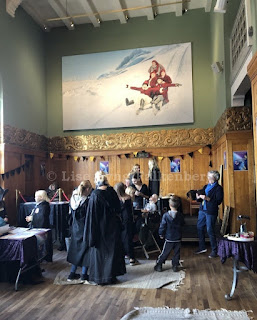Last year the
Harry Potter Festival here in Odense, Denmark, celebrated its 15th
anniversary. Over the years, the festival has grown from being a small, local
event organised by Odense Library for a handful of kids to a full-scale
festival taking place all over town and lasting three days with 10,000+
visitors. But not anymore.
This year Warner
Bros. said no, not just to the festival here in Odense, but to all Harry Potter
festivals world wide with more than 10.000 visitors. These festivals are no
longer allowed to use the Harry Potter name or any other name or invention from
the Harry Potter universe. I suppose Warner Bros. are afraid that the festivals
use the Harry Potter brand to rake in money, but to my knowledge most of the
festivals are free. Furthermore, the festivals play a huge part in the process
of passing on the love for Harry Potter and his universe to new generations of
readers as the books themselves are old hat by now. This way Warner Bros. is
saying no to free marketing to the younger generations, marketing that money
can’t buy.
With that said,
the festival still took place here in Odense, this time during October 18th-20th,
2018, but under a new name. Instead of the obvious choice, calling the festival
“The Festival That Must Not Be Named”, the new festival name is “Magic Days in
Odense” and as it is no longer a Harry Potter festival, it embraces everything
magic from every fantasy universe possible. When you walk down the streets you
no longer meet just the characters from Harry Potter like Dumbledore, Hagrid
and He Who Must Not Be Named, but also characters from “Lord of the Rings”,
“Game of Thrones” and “Narnia”. I for one met Mr. Tumnus!
Still, it was
clear that the festival had been planned as a Harry Potter Festival before
Warner Bros. stopped the event makers from using the Harry Potter name. Thus,
many of the activities were the same as previous years, but with new names. The
Dursley home was now called the Jensen home, Madam Malkin’s Robes was called
Madam Dorthea’s Robe Workshop, Honeyduke’s became The Sugar Fairy’s Candy Store,
St. Mungos Hospital was St. Albani Infirmary, Diagon Alley was Elf Alley, Eeylps
Owl Emporium became Feathers and Flying Owl Emporium, Ollivanders was Magic
Wand Emporium, Flourish and Blotts was Magical Writings and Stationary, The
Daily Prophet was Wizard Tidings, Borgin and Burkes was The Magic Second-hand
Shop and finally Gringotts became Fafner Bank and the currency Galleons became
Odinars.
Quidditch was
still the same, though, as quidditch was a real word long before Harry Potter
and the sport has become a real-life-sport with international rules and
everything. The ODEON film concert was also still associated to Harry Potter as
it was “Harry Potter and the Chamber of Secrets™ in concert” performed by
Odense Symphony Orchestra, but other than that it was difficult to find any of
the old names and characters.
Of the many new
things this year, I especially noticed three. The first one was what should
have been the Weasley home but instead of a visit to the Weasleys, festival
goers could now visit “The Pumpernikkel Family – a Magic Home”. It was still
the Weasleys, though, down to Mrs. Weasleys charmed knitting and the clock that
individually monitors each of the Weasleys whereabouts.
The second thing
that stood out was the making of a new, Nordic wizarding school called
Nordheim. Originally when the festival started now sixteen years ago, it was as
Hogwarts where a few kids were able to attend. Over the years, Hogwarts grew
and a couple of hundred students attended each year until 2010 where J. K.
Rowling visited the festival. Up until then Hogwarts had been situated in
Odense townhall, but that year Rowling used the town hall to read to a few
children and have lunch with Odense’s notabilities, so Hogwarts was closed that
year and remained closed every year since then.
Now that the
festival no longer has to do with Harry Potter, a wizarding school can be found
in the town hall again, namely the Nordheim Wizarding Academy, that consists of
four houses named after the four elements Fire, Air, Water and Earth. The
colour of the Fire house is gold and the house stands for intelligence,
diligence and bravery. The Fire house educates people of the law, hunters of
evil magic, dragon handlers and inventors. The colour of the Air house is
silver, and the house stands for friendship, loyalty and empathy. It educates
healers, rune throwers, astrologists, astronomers, soothsayers and unicorn
riders. The colour of the Earth house is green, and the house stands for
diplomacy, unity and respect. It educates diplomats, translators and linguists,
phoenix breeders, teachers and explorers. Finally, the colour of the Water
house is blue, and the house stands for ingenuity, patience and creativity. The
house educates potion masters, charm inventors, experts within maritime magic,
merpeople experts and alchemists.
In some ways the houses
of the Nordheim Wizarding Academy are similar to Gryffindor, Hufflepuff,
Ravenclaw and Slytherin, although they have merged a bit, but what happen
inside the walls of the academy I do not know, as this event was sold out in
advance, but from what I can see in the programme, the students were to learn
herbology, divination, runes, crystals, taming of monsters and how to use magic
in battle.
The third and
final event that caught my eye was called “Theatre Magic”. It had absolutely
nothing to do with Harry Potter, but still it was the best feature of this
festival. Usually the title of “the best” goes to the Brandts 13 Museum during
Harry Potter festivals, as the museum used to be the home of Madam Puddifoot’s
Tea Salon, The Fat Lady, Professor McGonagall and an annual surprise that has
ranged from the Prefects’ Bathroom over the Goblet of Fire to Fluffy the gigantic,
vicious, three-headed dog. But now Brandts 13 is closed to the public as it has
been turned into an art academy, so there is no tea, no surprise and worst of
all no McGonagall (who is an old acquaintance of mine) anymore. Instead you
could visit Odense Theatre where my sister knows the caretaker. Typical that
she knows the local Filch, she is a Slytherin after all, whereas I am
Ravenclaw.
In any case, the
visit to the theatre was quite exceptional as equipped with only a flashlight
(or like us the light from my mobile phone!) you were sent into the dark basement
under the theatre after having seen a short video about ghosts. You had to find
clues in order to get out again and the hunt for clues brought us all over the
theatre. First, we visited skeletons, monsters and very smelly fog in the
basement where we saw the revolving theatre scene from below as well. We came
through all kinds of wardrobes, workshops, prop rooms etc. on a backstage tour
of the theatre. We even crossed the stage and it was interesting to see the
theatre hall from the viewpoint of the actors. It actually seemed quite small
although the theatre has three floors. We ended up backstage with the local
“Filch” and he told us stories about the former theatre manager Helge Rungwald,
who since his death in 1960 has haunted the theatre. He has been seen many
times in the same spot on the balcony above the upstairs bar. We didn’t see
him, though, but luckily we managed to get all the clues so we were able to get
out of the theatre again.
Although there was
plenty to do at the festival as it consisted of about sixty different events,
it was still approximately ten events less than during the Harry Potter
Festivals. On top of it, it was a lot more expensive this year and furthermore many
of the events and shops only took “real” money. If you wanted to try
everything, you would have to use around DKK 1,700 (€228 / $283) in “real”
money plus money for food and whatever you had to pay in different shops and
workshops in Odinars. I was honestly a little shocked to find out that even to
enter a shop, no matter if you bought something or not, you had to pay between
100 and 300 Odinars to get in as during the Harry Potter Festival days you
visited shops for free, of course. Other activities during “Magic Days in
Odense” cost up to 600 Odinars and even a glass of butterbeer cost 750 Odinars.
In the bank you got 1,000 Odinars for DKK 50, so butterbeer was DKK 37,50 (€5 /
$6,25) and it didn’t even taste like proper butterbeer. Anyway, all in all per
person you would need perhaps DKK 2.500 (€336 / $416) to try everything at the
festival, but then again you can’t try everything as there are age restrictions.
At some of the events you had to be younger than fifteen to participate, at
others you had to be over eighteen.
Furthermore, some
events were sold out even before the programme was printed so you didn’t have a
chance to participate unless you knew about the events BEFORE the programme
came out. The sold out events were “The Magic Train” (formerly the Hogwarts
Express), “Visit the Wizard College”, “Slippery Snake Slime”, “The School of
Ghosts”, “Banquet at the Nordheim Wizarding Academy” and “ODEON – Film Concert”.
Doing the math, I
realised that if every visitor tried everything at “Magic Days in Odense”, the
festival would earn DKK 25 million (€ 3.4 million / $ 4,2 million), but of
course it doesn’t. In fact, I think the festival only breaks even, as making
such a huge annual festival is expensive. I have no idea if the festival is
going to have the same number of visitors in years to come, now that it is no
longer a Harry Potter festival, but I know that they can count me out. I’m a
Harry Potter film nerd (not so much the books), so this is the end for me. It
is really strange to write after all these years, but I won’t be back next
year.
Visit “Magic Days
in Odense” in 2019 if you like everything magic and has enough money to spend.
I won’t be there, though, as I can find better use for my money. So bye-bye,
annual festival. I still think “The Festival That Must Not Be Named” would have
been a better name.















